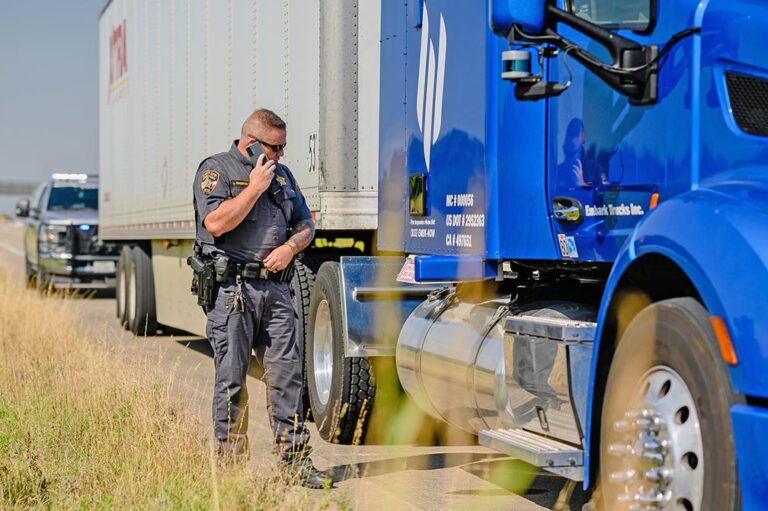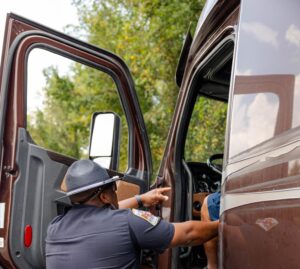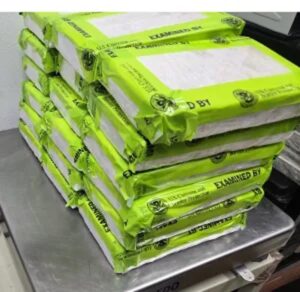SAN FRANCISCO — When truck drivers see flashing blue lights behind them, they pull over.
But what if there’s no one behind the wheel?
Autonomous technology company Embark Trucks, Inc. recently held a public demonstration of its emergency vehicle interaction capability by having a Texas Department of Public Safety (DPS) officer conduct a traffic stop on one of its autonomous big rigs.
Embark officials said they developed the pullover technique by working with DPS and the Travis County Sheriff’s Office (TCSO).
Embark-powered trucks can identify and stop for law enforcement vehicles in situations, such as traffic stops, and feature built-in communication protocols and standard operating procedures between autonomous trucks and law enforcement officers, according to a news release.
“This represents the first-ever public demonstration of an autonomous truck being pulled over by law enforcement and participating in a routine traffic stop on a public highway,” according to an Embark news release.
A video of the pullover can be viewed below this article.
“The ability to engage safely in emergency vehicle interactions is necessary to operate an autonomous vehicle on public roads,” Emily Warren, head of public policy at Embark Trucks, said. “Law enforcement always needs to be able to stop a commercial vehicle – autonomous or not – to ensure compliance with the law. This capability was designed to work seamlessly within existing law enforcement workflows, without requiring new training or technology investment by first responders.”
Embark officials are calling the technology “an engineering breakthrough for autonomous trucking with two key components.”
They are:
- Embark’s engineering team built the technical functionality for the capability. This included training Embark-powered trucks to identify emergency vehicles via lights and other cues, and then respond accordingly by pulling over safely onto highway shoulders.
- Embark developed an interaction procedure with input from law enforcement that can enable any law enforcement officer to safely stop, approach and receive information from an autonomous truck intuitively and without any additional equipment. When commercially deployed, this effort may include outfitting Embark trucks with clear visual cues and information to signal to law enforcement and other first responders that an Embark-powered truck is an autonomous vehicle and has come to a safe stop with no risk of restarting unexpectedly. Embark’s externally accessible lockbox, containing information such as registration and bills of lading, as well as a toll-free number to contact an Embark Guardian support technician, are also included in the company’s plans to assist law enforcement officers as they perform roadside traffic stops.
“Together, these features represent a comprehensive process for Embark-powered trucks to comply with law enforcement requests, just like a human-driven truck would respond in similar situations,” the news release stated.
To develop this capability, Embark, TCSO and Texas DPS executed comprehensive data collection and testing from April to June that included closed-course activity at the Texas A&M University RELLIS Campus test track as well as public road demonstrations.
“During Embark’s industry-first demonstration, which took place in late June on Texas State Highway 130 near Austin, deputies from the TCSO’s Commercial Vehicle Enforcement division followed an Embark-powered truck along a designated route and successfully completed a traffic stop of the Embark truck,” according to the news release.
A deputy was able to confirm the truck was safe to approach via an external status display on the side of the truck, then walked through the procedure of accessing the truck’s documentation via an external lockbox, using a code that would be provided by a remote Embark Guardian support technician.
The demonstration concluded after the deputy completed his traffic stop and followed the truck as it re-entered highway traffic.
The Trucker News Staff produces engaging content for not only TheTrucker.com, but also The Trucker Newspaper, which has been serving the trucking industry for more than 30 years. With a focus on drivers, the Trucker News Staff aims to provide relevant, objective content pertaining to the trucking segment of the transportation industry. The Trucker News Staff is based in Little Rock, Arkansas.















Just a few questions. If the semi is driven autonomously, is it loaded, and unloaded autonomously too? Do the e-logs fill themselves out? Does the vehicle have to follow the 30 minute break rule? How does it take on fuel?
All this does is show how A.I. will take away more jobs .
Anyways if vehicles are inspected regularly by say A I. there shouldn’t be a reason for traffic stops , A.I. would t lie or miss anything during inspection or let anything go that wasn’t right .
CORRECT ??
And if they cause an ACCIDENT who is charged !?
Show a level 1
Not just a level 3
How is it going to complete a pre and post trip? Sure, it can sense the tire pressure but it cant check the tire for damage. There are so many other things in a pre trip that are visual that you cant see from a mounted camera. For that reason and the fact that the general public will never accept an 80k pound vehicle driving on the roads with them without a human in at least some control of it makes this a non starter of an idea.